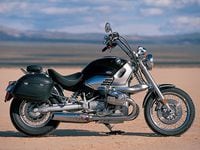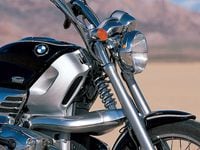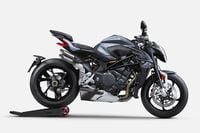Because it is so different than other cruiser motorcycles, some people don’t believe that the 1200C actually fits into the cruiser phylum. That’s only true if you believe that a cruiser must have a V-twin engine and traditional American styling. However, if you believe a cruiser simply requires a certain attitude, riding position and nostalgic styling, then the BMW fits the bill perfectly. The 1200C incorporates classic BMW styling cues, starting with the opposed-twin engine. Despite its modern mid-cam valve actuation, oil-cooled heads, four valves per cylinder and electronic fuel injection, the 1170cc engine bears a close family resemblance to its Bavarian ancestors.
Viewers with a limited scope also take issue with the Telelever front suspension, but BMW’s use of telescopic forks is relatively new. The Earles fork, to which this has a vague resemblance, was a BMW tradition. The Telelever also permitted BMW to minimize the aluminum frame and make the engine a primary chassis component. The geometry of the design reduces dive under braking. At the rear, the single shock and one-sided swingarm impede the view of the wire-spoked rear wheel less than a hardtail. The wheels may be the perfect example of BMW’s ability to meld tradition (wire spokes) with modern technology (tubeless tires). Stopping comes from three disc brakes with anti-lock braking (ABS), a $1300 option and one that we highly recommend.
The tallest handlebar here and the small passenger pad (which hinges up to become a rider backrest and reveal a luggage platform) give the bike a chopperesque quality. The lines of the tank, the rear fender’s shape and the black-with-white-pinstripes finish evoke BMW models from even further back in time than the 1948 model recalled by Harley’s Heritage Springer.
Everything considered, the 1200C couldn’t be anything but a cruiser.
This article was originally published in the August 1998 issue of Motorcycle Cruiser.


/cloudfront-us-east-1.images.arcpublishing.com/octane/52GPADYLYZFEDJ6WKHNF44PYNU.jpg)
/cloudfront-us-east-1.images.arcpublishing.com/octane/SWMZI3VS7NANXHECY5KVQO47BE.jpg)
/cloudfront-us-east-1.images.arcpublishing.com/octane/6F5UZMOWJFDRXDHN66HSW7725E.jpg)
/cloudfront-us-east-1.images.arcpublishing.com/octane/SNQEMPXRCBDKPCXJIN24D4J22M.jpg)
/cloudfront-us-east-1.images.arcpublishing.com/octane/GXHESE63GNGPLEOJ2JJANNGQ5Q.jpg)
/cloudfront-us-east-1.images.arcpublishing.com/octane/3USOOXJEHJB6NB2NNKU73HMRVY.jpg)
/cloudfront-us-east-1.images.arcpublishing.com/octane/6GLBGD7S75B7JP2GRYNEJO4TBE.jpg)
/cloudfront-us-east-1.images.arcpublishing.com/octane/SCA4CUE6YBHGRHKU7HEG3YHWGQ.jpg)
/cloudfront-us-east-1.images.arcpublishing.com/octane/LICXFHEM45CJZNVP6K36OVJSYQ.jpg)
/cloudfront-us-east-1.images.arcpublishing.com/octane/AJKZ2F5GIZEZREL5JQTKYYJ54E.jpg)
/cloudfront-us-east-1.images.arcpublishing.com/octane/R6QOQ7QOEJBVXP6CXT3R2LABII.jpg)
/cloudfront-us-east-1.images.arcpublishing.com/octane/KLI2FNJIQFEZVDXOAGYNOIN5HA.jpg)
/cloudfront-us-east-1.images.arcpublishing.com/octane/MVZFYJGVT5HRHC3XC3IT3IRPKE.jpg)
/cloudfront-us-east-1.images.arcpublishing.com/octane/JHRO6BMI45AZXB5TQ3RPZOQYPQ.jpg)
/cloudfront-us-east-1.images.arcpublishing.com/octane/BWG25O2D65H6LBEX4FQGHIBJAE.jpg)
/cloudfront-us-east-1.images.arcpublishing.com/octane/57PFATNDVBCCBFNWWTFYOFKSXM.jpg)
/cloudfront-us-east-1.images.arcpublishing.com/octane/TUXX7GKOQVFV7M7PAFUAPCJZXQ.jpg)
/cloudfront-us-east-1.images.arcpublishing.com/octane/DLOHA4WLMRFZRGJAKE7BYE2LPE.jpg)

/cloudfront-us-east-1.images.arcpublishing.com/octane/KILTQJNSDFDHTPC7DCUJ43S4CA.jpg)
/cloudfront-us-east-1.images.arcpublishing.com/octane/X47GL62AXNALRHQLLBELY5WRMY.jpg)
/cloudfront-us-east-1.images.arcpublishing.com/octane/7OY2GP3FWFEDVEMDSLNGM6PZRM.jpg)
/cloudfront-us-east-1.images.arcpublishing.com/octane/P3DLTISFGJA43L5QXVH7365UNY.jpg)
/cloudfront-us-east-1.images.arcpublishing.com/octane/SMCEQCLWRVEFTJJES6TAHB3OOQ.jpg)